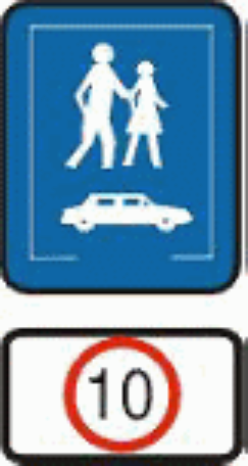DKT Test (Speed Limits) #2
On a school day, it is 9.20 a.m. You're travelling at 60 km/h, the same as the rest of the traffic. You drive past this sign, but the other automobiles do not appear to be slowing down. What are your options?
Explanation:
Because there may be minors present, the speed limit is 40 km/h.
If you're traveling down the highway and come across road construction with a reduced speed zone, you must slow down.
Explanation:
The lower speed zone is in place to ensure the safety of any road workers, as well as because higher speeds may cause road conditions to become slick or dangerous to your car.
You're travelling in a 70 km/h zone and staying inside the speed limit. You are passed by a number of automobiles. One of your passengers advises that you keep up with the rest of the traffic. So, what are your options?
Explanation:
If you're driving within legal boundaries, you're in charge, and it's not up to your passengers to tell you how to drive.
Drivers are advised by speed limit signs to:
Explanation:
You are not permitted to violate the posted speed limit.
In an 80 km/h zone, you're stuck in heavy traffic. It starts to drizzle lightly. So, what are your options?
Explanation:
Rain can make the road slicker, and it can limit vision. It is safer to drive at a speed that is more appropriate for the conditions.
When you see this sign, you must do?

The correct answer:
Not exceed 40 km/h and keep a special lookout for bicycle riders, pedestrians and children.
How does increasing your speed from 20 mph to 40 mph affect your overall stopping distance?
Explanation:
When your speed doubles from 20 to 40 mph, your stopping distance and power of collision increase by a factor of four. From 20 to 60, tripling your speed results in a 9-fold increase in braking distance and impact. From 20 to 80 mph, quadruple your speed, and your braking distance and impact are 16 times greater.
How do you determine when it is safe to pass when you are following a slow car that is traveling below the speed limit?
Explanation:
There is only one car to pass and no oncoming traffic, so you won't need to go very fast. Passing while going over the speed limit is prohibited. Passing several vehicles at once is risky.
What should you do when you safely begin passing a car before moving back to the right lane?
Explanation:
All of the above. Wait until you can see the front tires of the car you passed in your rearview mirror before switching back to the right lane. Before approaching any vehicle approaching from the other way within 200 feet, you must go back to the right side of the road.What should you do if a vehicle starts to pass you?
What should you do if a vehicle starts to pass you?
Explanation:
Avoid accelerating and moving to the right of your lane. Giving passing drivers more room and a better view of the road ahead, move to the right side of your lane.
If a slow-moving car is in front of you as you approach an intersection with a green light, is it safe to move around the car in the intersection given that the signal is green?
Explanation:
No, passing is not permitted within 100 feet of an intersection. Because you can't see them, they might be slowing down for cyclists, pedestrians, or other vehicles, which is extremely dangerous.
What are the locations where you are not permitted to pass within 100 feet?
Explanation:
Do not go within 100 feet of a railroad crossing, viaduct, tunnel, bridge, or intersection.
Can you pass the stopped vehicles on the right shoulder if it is clear?
Explanation:
Florida law prohibits passing on the right shoulder. Never leave the road to pass another vehicle. If the road has more than one lane and you are passing in the right lane, only do so (not the shoulder.)
When can you pass?
Explanation:
On a single broken white line, passing is permitted. When it is safe to do so, you can cross this line to switch lanes.
When is a slope or a curve a safe place to pass?
Explanation:
If the road is clear for 500 feet or more on a slope or curve, you can pass.
How do you respond when the car in front of you tries to change lanes and pass you?
Explanation:
If you need to, gradually slow down to make room for them.
What should you do if you're driving along a highway with a divided raised barrier and notice a School Bus on the other side of the barrier with a stop sign out?
Explanation:
Continue driving. If you are traveling in the opposite direction of the school bus and the roadway is split by a raised barrier or an unpaved median that is at least five feet wide, you do not need to stop.
Only if you're traveling in the same direction as the school bus should you stop.
Should you speed up towards the roundabout as you approach it to avoid a car turning around?
Explanation:
No, those entering a roundabout must make way for those who are already inside. Enter the roundabout if there are no vehicles there. While at a roundabout, do not stop or make any changes. Use your turn signal to let other drivers know when you are ready to leave the roundabout.
What could the penalties be for exceeding the speed limit?
Explanation:
For violating the speed limit, you risk receiving a large fine, losing your license, and racking up demerit points.
This sign indicate:

Explanation:
On this route, you'll be driving alongside other cars and pedestrians. There is a 10 km/h speed limit.